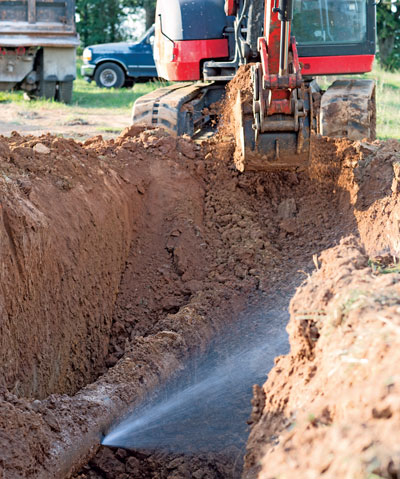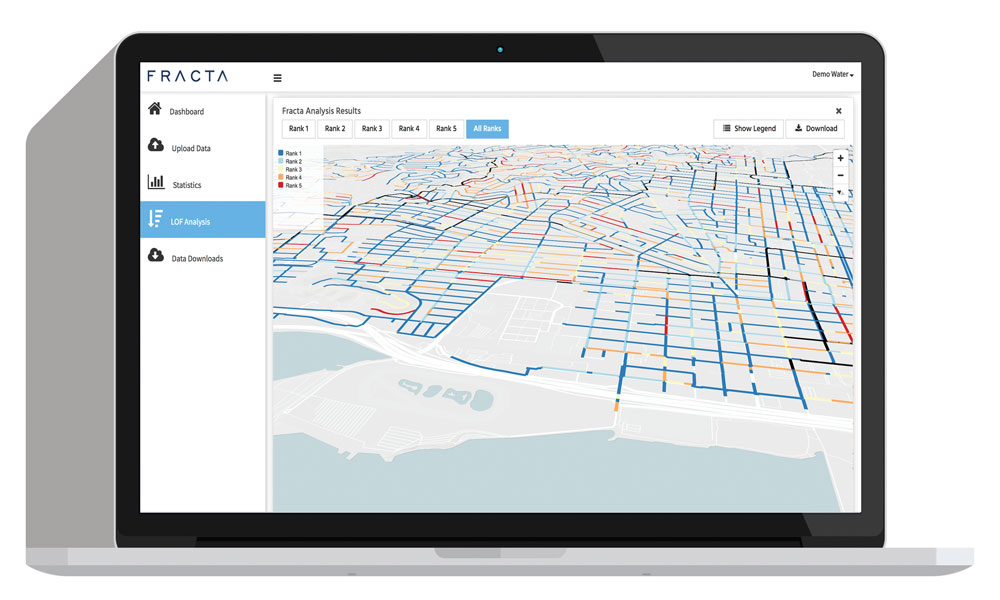
GASB 34 Reporting of the Value of Buried Infrastructure
Using Artificial Intelligence and Machine Learning to Assess and Monetize the Condition of Water Mains
Asset Management practices combined with the latest condition assessment tools using artificial intelligence, specifically machine learning, to assess the condition of water buried water mains provides a new method for aligning maintenance, repair and replacement strategies to better allocate limited resources.
Underground pipe performance evaluations can be established with an objective, data driven approach like machine learning and used to meet accounting’s GASB 34 Modified Approach requirement of a system-wide condition assessment three years. This greatly reduces the time required by accounting to report on buried infrastructure systems while increasing the accuracy and value of the financial statements.
Machine learning-based condition assessment tools are now commercially available. One example is Fracta. Fracta offers a fast, accurate and affordable digital condition assessment solution to predict the Likelihood of Failure (LoF) of water distribution mains. The accurate LOF score can then be coupled with Consequence of Failure (COF) to calculate a monetized Business Risk Exposure (BRE) and an estimated replacement cost for every buried water main in a distribution system.
GASB 34: Depreciation and Modified Approaches
GASB 34 requires that state and local governments report the value of their infrastructure assets in their annual financial reports on an accrual accounting basis. Under accrual accounting, the cost, or the loss in value, of an asset is spread across the asset’s useful lifetime rather than accounted for in its first year. Accrual accounting keeps infrastructure assets on the books and is more consistent with the reporting of other costs of doing business. By reporting the value of assets over time, improvements or lack of improvements in public assets becomes more apparent.

- Under the Depreciation Approach, the cost of an asset is spread as an expense across its useful life (estimated service life).
- Under the Modified Approach, assets are considered inexhaustible and are not depreciated against a service life schedule, instead only the actual cost of maintaining infrastructure assets is reported.
Asset management and GASB 34 are geared to fuel and encourage the strategic, proactive management of infrastructure. As utilities engage in a focused asset management program, they should use care in the selection of their preferred reporting method since the practical effect of either one in practice can have very different results.
The objections to the Depreciation Approach for infrastructure assets include:
- Depreciation is not an accurate number for determining a replacement cost as it does not account for the increase in asset cost due to inflation which will impact replacement planning needs.
- Depreciation does not indicate how well an agency is caring for its assets.
- It is difficult for utility managers to see from the financial statements the “true” cost of asset ownership.
- When many assets have exceeded their useful life, the reported costs may seem low when in fact there are huge, unavoidable replacement needs in the near future.
- Depreciation does not report on the condition of assets which bond holders could interpret as either (1) the utility doesn’t know the condition of its assets; or (2) the utility knows, but would rather not say.
The modified approach appears beneficial to utility asset managers. By tying expenditure levels directly to infrastructure condition, managers can justify adequate levels of re-investment in their systems. Managers can also demonstrate that they know and care for their infrastructure, which supports better bond ratings and governing bodies therefore are more likely to fund the infrastructure needs.

Qualifying for the Modified Approach
In order to qualify to use the Modified Approach, governments must meet two requirements. First, they must manage their eligible infrastructure assets using an asset management system, and second, they must document that the infrastructure assets are being preserved at (or above) a condition level (target) established by the government.
An asset management system is a formal process of maintaining, upgrading, and operating physical assets cost-effectively. It combines engineering principles with solid business practices and economic theory, and it facilitates an organized, logical approach to decision-making. GASB 34 identifies the following characteristics of an asset management system that would support the use of the Modified Approach:
- Inventory updates for eligible infrastructure assets
- Condition Assessments of the eligible infrastructure assets using an objective measurement scale
- Annual estimates of amounts to maintain and preserve the eligible infrastructure assets at the condition level established and disclosed by the government.
The second requirement for the Modified Method is to document that eligible infrastructure assets are being preserved approximately at or above a condition level established and disclosed by the government. While GASB 34 observes that professional judgment will be necessary when determining the adequacy of documentation, it also states that governments should document the following:
- Complete condition assessments of eligible infrastructure assets occur at least every three years in a consistent manner.
- The results of the three most recent complete condition assessments should provide reasonable assurance that the eligible infrastructure assets are being preserved approximately at (or above) the condition level established and disclosed by the government.
A condition assessment measures the collective condition of assets within a network or subsystem. An assessment of individual assets is not necessary, but may be performed using statistical or other sampling methods. Trained individuals using prescribed forms or analytical techniques should undertake condition assessments. GASB 34 does not specify attributes of infrastructure assets that should be measured when performing assessments. Consequently, governments may use an attribute or any combination of attributes that they consider appropriate.

Traditionally, condition assessments of buried water mains typically fall into two categories: Indirect and Direct. An indirect desktop study method should always occur first. A direct or physical inspection and condition assessment is accurate for the pipe tested but it tends to be slow, very expensive and labor intensive. Multiple physical measurements are required for correlation and confirmation. The results are difficult to extrapolate to system wide recommendations which could be based on arbitrary assumptions and weights (i.e., older pipes are more in need of replacement than newer pipes).
A performance-based buried infrastructure management approach involves a detailed inventory by pipeline segment and monitoring how well individual pipelines are meeting the level of service that is required of them. Since buried infrastructure is not readily accessible, performance-based management of these buried assets has historically not been performed in the water industry.
A more robust approach would be a large-scale comparison of various factors to generate a more refined and accurate prediction-based assessment on the disparate interactions between component variables. Machine learning has emerged as a technology to make a significant impact in buried water infrastructure asset management. Machine learning consumes large, complex data sets containing more variables than what humans can process with current tools. This objective, data-driven method overcomes human limitations with their inherent subjectivity and biases and provides more accurate results that help utilities make better replacement decisions.
Using Machine Learning for Condition Assessment
Due to the large amount of historical and geospatial data needed to run machine learning algorithms, water main condition assessments contain all the necessary components of an ideal application for water utilities. Pipe data and the surrounding environmental data covering installation year, pipe material, break history, pressure class, geographical location, elevation, pipe diameter, proximity to other infrastructure systems and soil composition can all be taken into consideration while also assessing hundreds of other variables unique to a specific utility and pipe location. Analyzing this data consistently can uncover trends, gain insight on pipeline health, and offer data-driven assessments.
Machine learning algorithms need a large amount of historical and geospatial data. Water main condition assessment data contains all the necessary components for machine learning in water utilities with years of historical data. Analyzing this data consistently can uncover trends, gain insight on pipeline health, and offer data-driven assessments. The more data the better, as the amount of data strengthens the predictive power of a machine learning algorithm.
Data acquisition, assessment, and cleaning for any machine learning process is roughly 60-80% of the work, also known as pre-processing or data wrangling, with the remaining percentage being the machine learning itself. Once the data is assessed, cleaned, and imputed where needed, it is ready to be fed into a machine learning algorithm where it is subsequently ‘trained’ to learn the patterns that predict breakage events. The Fracta process for the condition assessment of buried water mains is illustrated in the following diagram.
New pipe data strengthens the predictive power of a machine learning algorithm. Machine Learning can also benefit utilities with limited asset or breakage data by “filling in the gaps.” Machine Learning can utilize many streams of data in order to perform certain predictions and begins to learn patterns that can inform situations where many of the usual data points may not be available creating a new digital revolution in advanced asset management practices. The more data a model contains, the more robust the model. As utilities are over time constantly collecting data such as new breaks and installed pipes, that data can continually be fed into a machine learning model.
Incorporating a machine learning condition assessment into a proper infrastructure and asset management program will enable utilities to meet the Modified Approach under GASB 34 for reporting the value of buried water mains. This will contribute to more accurate accounting of the value of the assets. It also contributes to the reduction of economic impacts incurred from water main breaks, and more efficient allocation of funding by water utilities. Use of best practices and a more accurate, objective tool will align maintenance and capital repair and replacement strategies to more efficiently leverage scarce financial and human resources. They also inject financial integrity and accountability to the planning process and refine the investment strategy so a utility will be in a better position to defend planning efforts and justify pipe replacement projects.




